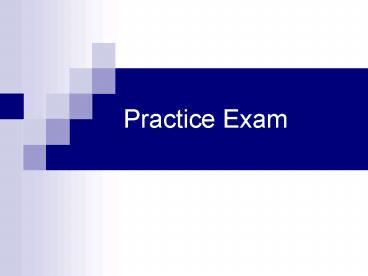Practice Exam - PowerPoint PPT Presentation
1 / 13
Title:
Practice Exam
Description:
Concern about methyl bromide getting up into the stratosphere and ... Discuss this concern and how it can be abated, other than reducing the swine population. ... – PowerPoint PPT presentation
Number of Views:29
Avg rating:3.0/5.0
Title: Practice Exam
1
Practice Exam
2
- (10 pts) The figure on the left illustrates the
challenges to an environmental chemist. (a)
Using acid rain as your illustration, discuss
where as a result of a chemical reaction, SO2,
the pollutant/contaminant can affect an
ecosystem.
The points to emphasize here are (1) that SO2
itself is not a problem until it is oxidized to
H2SO4 SO2 ? SO3 ? H2SO4 The acid will change
the pH in aquatic systems resulting in fish
kills, or affecting trees, particularly those at
high elevations in low-lying clouds.
3
(b ) Using indoor air, discuss briefly, how a
pollutant/contaminant can affect human health
(Any of the pollutants we discussed in class will
be acceptable).
- Whether you are talking about asbestos, smoke, or
radon, some discussion of cancer. There are
differences in how the pollutant causes the
cancer whether radioactivity (radon) or physical
fibers (asbestos).
4
(5 pts) Complete the table below that shows the
atomic effects as a function of energy/wavelength
Region Atomic Effects
Microwave
Infrared
Visible
Ultra-violet
X-ray, g-ray
5
(5 pts) Complete the table below that shows the
atomic effects as a function of energy/wavelength
Region Atomic Effects
Microwave Rotation
Infrared Vibration
Visible Electronic excitation
Ultra-violet Bond-breaking
X-ray, g-ray Bond-breaking
6
( 10 pts) List two concerns that have resulted
from the destruction of the ozone layer in the
stratosphere.
- What I am looking for here is a discussion
involving cataracts, skin cancer, or amphibian
decline. Discussion must include an increasing
of UV-B radiation as a result of ozone loss.
7
(15 pts) One of the compounds believed
responsible for the destruction of the ozone
layer, is CF2Cl2
- Show a series of reactions beginning with the
photolysis of CF2Cl2 that would result in the
destruction of ozone (CF2Cl2 --l-gt CF2Cl Cl). - O3 Cl ? ClO O2
- ClO O ? Cl O2
- List two sources of CFCs.
- Refrigerants, cleaning solvents, blowing agents
- Write a chemical reaction that could remove Cl
from the stratosphere. - CH4 Cl ? HCl CH3 or Cl
Cl ? Cl2
8
(15 pts) Explain what causes the ozone hole to
appear and why it occurs in late October/early
November (Be as specific as possible, using
chemical reactions).
- Earth turns and Antarctic region gets cold and
has no sunlight - HNO3.3H2O precipitates out.
- HCl and ClONO2 undergo transformation to HOCl and
Cl2 - Earth turns, UV light appears, HOCl ? OCl H or
HO Cl - Also, Cl2 ? 2 Cl
- Destruction begins.
- Earth Continues to turn HNO3 melts, UV cleaves
HNO3 and OCl is taken out of the system
9
(10 pts) A compound, methyl bromide, CH3Br, used
by regional strawberry farmers has been placed on
a list to be eliminated by 2005 because of
concern about ozone depletion. Please explain.
- Concern about methyl bromide getting up into the
stratosphere and causing the destruction of
ozone. - CH3Br --l ? CH3 Br
- Br O3 ? BrO O2
- BrO O ? O2 Br
10
(15 pts) The main compound responsible for acid
rain is SO2 emission.
- Explain why it is a problem down wind, and not in
the immediate vicinity of where it is released. - SO2 is oxidized to H2SO4 and this is a slow
oxidation-reduction reaction requiring time to
occur, resulting in the sulfuric acid to be
created a long distance from the source. - List two ways in which SO2 emission can
reduced/eliminated. - Conversion to another product (scrubber),
dilution, or remove as an impurity. - List three effects resulting from acid rain.
- Vegetation, natural waters, health, or structure
damage
11
(10 pts) One of the major regional concerns is
nitrogen deposition as a result of the increasing
swine population in SE North Carolina. Discuss
this concern and how it can be abated, other than
reducing the swine population.
- Nitrogen deposition from the atmosphere resulting
in a nutrient overload causing algal bloom and
fish kills. - This effect can be mitigated by changing the
lagoon system for treating the hog waste.
12
What conditions must exist for a city to have the
potential problem of photochemical smog? Show,
using chemical reactions, why we monitor the
presence of ozone in the troposphere to indicate
pollution.
- N2 O2 ----gt 2 NO(Combustion)
- 2 NO O2 lt--gt NO2 (rev. rx. slow)
- NO2 -hnlt400 nm-gtNO O
- (UV-A, UV-B)
- Sum of NO2 and NO given as NOx
- O O2 ---M---gt O3
- O3 ---hn, lt320 nm ---gt O2 O
- Both in ground states or excited states, UV-B
radiation is required to dissociate ozone into
O(excited state) - O H2O -----gt 2 OH Must be in excited state
to overcome repulsion
- Conditions for photochemical smog are
- Stagnant air
- NOx and VOCs
- High temperatures
- Sunlight
13
How did you do?

